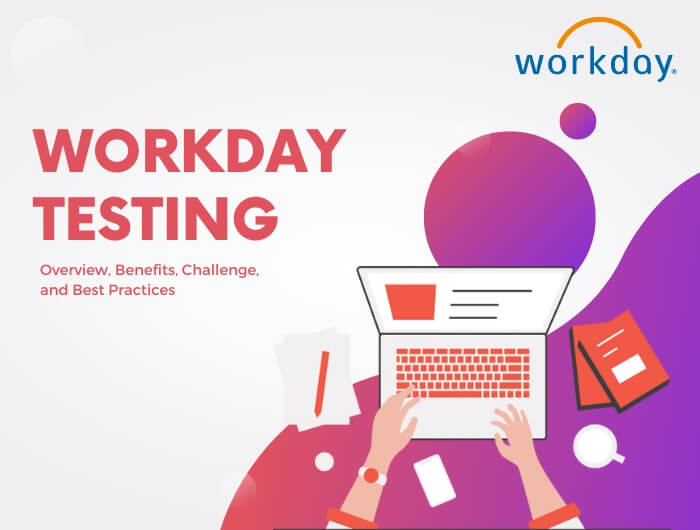Workday Testing: Overview, Benefits, Challenge, and Best Practices

In the past few years, the demand for cloud-based enterprises has significantly increased, and Workday is one of them. It is a globally used application, aiding in HCM (Human Capital Management). Workday is one of the most prominent HCM software with more than 15% of the Human Resource Management System market. It helps businesses reduce errors and maximize operational efficiency.
However, businesses need to be mindful of the interaction of the third party and their current system to operate as intended. That’s where Workday testing comes in. It ensures data security, integration, reporting, and the system’s functionality.
Moreover, Workday testing can be done manually and automatically, and Workday testing tools are used for automation testing. In this blog, we delve into the overview, importance, challenge and best practices to follow.
Understanding Workday Testing
The Workday platform has many functionalities, from hiring to financial accounting. So, organizations need to focus on implementing the Workday and getting the best out of it. That’s where Workday testing comes into the picture. It is a process to verify and validate the performance, functionality, and security of the Workday system, helping you identify that it is working as intended. Furthermore, businesses can perform Workday testing manually or through Workday testing tools.
Importance of Workday Testing
Implementation of Workday comes with its set of challenges, and Workday testing ensures that the software fits your business requirements. Performing the Workday testing has several advantages for organizations.
Minimize Risks
Businesses perform the testing using Workday testing tools or manually, which helps them identify and mitigate the problem before going live. It helps improve system performance, reducing error chances, risk of downtime, and security breaches.
Enactment of Workday
The configuration can be changed during the execution of Workday, and it can be problematic during the operation. Testing ensures that the system is working as intended.
Enhance User Experience
Performing the Workday testing helps organizations identify the issues or bugs early and fix them immediately to provide a smooth experience to users.
Ad-Hoc Workday Testing
If there is any change in an organization’s existing workflow, any third-party system is integrated, or in case of software updates, business operations should not get disturbed. That’s where Workday testing comes into play.
Workday Updates
Workday released multiple updates in a year, and due to this, the integration and customization process can be impacted. Workday testing ensures that business operation isn’t impacted.
Common Challenges During Workday Implementation
Discovering the Right Implementation Partner
Workday is quicker and more iterative compared to other ERP systems, and it works with employees’ processes in the organization. So, it becomes essential for an organization to select the right partner to help reduce the implementation complexity. It saves too much time and money.
Data Migration
Data migration is one of the most challenging tasks with any software, and Workday is no different. Matching the existing data format with the application might be a daunting task, and if data migration is not done properly, it can lead to duplicity.
Absence of Proper Documentation
Implementation of Workday is a challenging process involving multiple actions. So, documentation of every step is vital. This documentation helps with future modification and testing. Moreover, many organizations don’t have the proper documentation, which makes the Workday implementation challenging. Without documentation, an organization faces challenges after each Workday release.
Update During Execution
Workday releases two updates annually, and one of these can be encountered during or after launch. In this case, there could be a certain dip during the integration.
Existing HR Practices
HR practices vary in each organization, such as leave management, hiring, payroll, employee benefits, and others. Due to this, problems arise during the implementation of Workday, as Workday must match with the existing operation procedure.
Best Practices to Follow While Workday Testing
Plan the Testing
Before you begin, plan the testing whether you need a manual or automated approach. For an automated approach, you can use Workday testing tools to perform testing. After this, define the objective, requirements, and prioritization of functionality.
Incorporate the Testing Techniques
There are various testing techniques, and you should incorporate them into your organization for comprehensive testing. Moreover, functional, regression, performance, and security testing are some techniques.
Test Integrations Thoroughly
During the Workday implementation, organizations must ensure successful integration with third-party and legacy applications. So, perform the testing thoroughly to ensure an application’s smooth data flow and intended working.
Analyze Test Report
After testing, analyze the results to gather insight to identify the potential problem and improve the testing approach.
Ensure Effective Collaboration Among Teams
Ultimately, it is vital for a smooth testing process, and organizations can achieve this by enabling effective communication between developers, business analysts, testers, and end users.
Streamline Workday Testing With Opkey
Performing the Workday testing is vital for ensuring the better performance and functioning of your Workday application. However, testing can be a challenging task. That’s where Opkey comes into the picture. It is a no-code testing tool, helping you minimize risk, ensure compliance, and enhance experience.
If you are looking for Workday testing tools, don’t look further than Opkey. It enables end-to-end testing that is cost-effective and ensures the security within your organization with instant alerts. Contact Opkey and streamline Workday testing!
Suggested Read: National Stress Awareness Day






